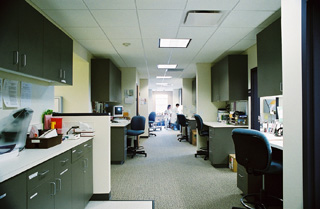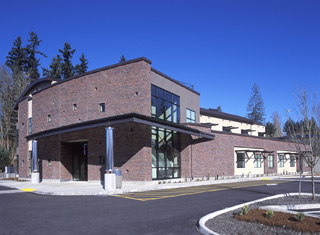|
Subscribe / Renew |
|
|
Contact Us |
|
| ► Subscribe to our Free Weekly Newsletter | |
| home | Welcome, sign in or click here to subscribe. | login |
Architecture & Engineering
| |
 |
July 26, 2012
Clinic designs evolving to meet growing list of needs
Johnson Architecture & Planning

Johnson
|
Johnson Architecture & Planning has been designing primary care medical and dental clinics since its founding in 1987, with a focus on community-based nonprofit health care providers. Clinics for Peninsula Community Health Services in Port Orchard and Community Health Care in Lakewood are two recent examples.
Each of the medical and dental clinics we design is in many ways an evolution of previous projects, and in just as many ways unique in its site, operations and response to its community. We must consider in every project how to balance and provide for the needs of three distinct user groups — patients, providers, and operations and management staff — and also consider how new aspects of the health care industry will influence design.
Patient experience
We believe that good design can improve medical outcomes.
In every clinic design, we bring some basic guiding principles that stem from the client’s mission of providing professional care in a healing environment. These principles apply to the patient’s experience as well as to the providers and the clinic management team.
The patient’s experience and its effect on the design is one of the first things to consider. Wayfinding and patient circulation stand out among many important factors. The patient’s progress from reception to waiting, intake, triage, exam room and checkout is a path that requires interaction with many people and has its own particular geometry. The path can also include financial aid, counseling, lab work and the pharmacy.
To help the patient feel welcome, safe and respected, we plan clear, understandable circulation patterns from the parking lot to the exam room and back out while also making it easy to find personal assistance.
We make efforts to maximize the use of interior daylight both for psychological reasons and for simple orientation: Light at the end of a corridor can almost instantly remove the sense of a clinical maze. A wall of glass looking out over plantings can provide relaxation in a dental suite, and a skylight can accent an important circulation node or provide relief in a stressful environment.
Color and texture changes are common techniques to help patient wayfinding. We also use change of ceiling heights, dropped soffits and changes in lighting to distinguish patient areas from medical support areas, provider offices and medical assistant stations.
We also have to recognize the patient demographics and accommodate those specific needs. Frequent need for translation services for large families may affect the exam room module. Large numbers of families with children will affect the waiting room size and features.
For the clinic in Port Orchard, which sees many young patients, we placed toddler-height windows in the waiting room that have been well-received by the kids. These windows also provided a way of humanizing the scale of the exterior architecture.
Staff experience
The provider and medical staff side of this three-way equation also presents its specific challenges.
Patients are often one-time or infrequent clinic users who place demands on the clinic design for clarity and comfort. But the clinic design defines the everyday working environment of the medical and dental staff. Our task is to express their workflow in the design in ways that allow for efficiency, privacy and less stress.
Efficiency can mean providing offices with privacy, organizing exam rooms that minimize the provider team’s footsteps, adding a second exit so staff can leave the clinic without going through the waiting room, or designing medical assistant stations that have enough workspace and sufficient, well-located storage.
The third user group to consider is the clinic operations and management staff, which will also often include supporting counseling and social services staff.
These clinic employees will have relationships with both the patients and with the provider staff. They need to be readily accessible to the patients, ideally directly from the waiting room or reception area. They also need to communicate with the providers, often face-to-face.
Accommodating these operational and managerial spaces into the rigorously planned patient and provider circulation and workflow can be a challenge, particularly on an urban site where the external site geometry often dictate the building shape.
Recent changes
In addition to integrating the needs of these three clinic uses in the design process, other recent changes to health care clinic operation will affect clinic design.
Changes to regulatory requirements for privacy and security, evolving philosophies of service delivery, and introduction of new technologies all require attention in the design process.
One of the biggest recent influences on clinic workflow organization is the introduction of electronic records. While the elimination of the medical records file room is an obvious and dramatic change, and the provision of terminals in each exam room a less dramatic one, we believe there will be many more subtle changes in how electronic records and health information will affect clinical operations.
There are also two additional and relatively new operational elements that are affecting clinic design, at least in our experience: the addition of residency programs to traditional primary care medical clinics and centralized medical lab operations.
Residency programs introduce medical students as practicing resident staff-in-training within the clinic. These programs add requirements for additional group offices, conference and classroom facilities as well as program management and medical supervisory staff. From a design perspective these programs provide an interesting and complicating element to the basic clinic diagram.
As primary care clinics grow and begin to incorporate specialties, centralized lab services begin to make sense. Removing the laboratory from within the clinic and placing it within its own space allows a more efficient clinic layout. A centralized lab may also reduce demand in the clinic waiting area and allow patients to proceed to the lab after their clinic visit.
A successful clinic design is supportive to its medical staff, effective for its operations and also respects and anticipates the needs of the patient. Such a design also responds to changes in how organizations provide health care.
One must also respond to developments and new regulations in the health care industry. While the clinic environment evolves continually, satisfaction comes from a design that responds well to all of these concerns and serves its users well into the future.
Steve Johnson is principal of Johnson Architecture & Planning, an architectural practice focused on urban design.
Other Stories:
- Lean design is different for every health care project
- Simulations playing wider role in nursing education
- Former TV studio remodeled into dialysis clinic
- Silverdale hospital sets ambitious budget for new wing
- Virtual tools put Everett tower on the fast track
- Hospital’s mechanical design process a complex dance
- When hospitals expand, traffic concerns follow
- Tight UW site left nowhere to go but up
- Builder’s challenge: Keep UW hospital running smoothly




